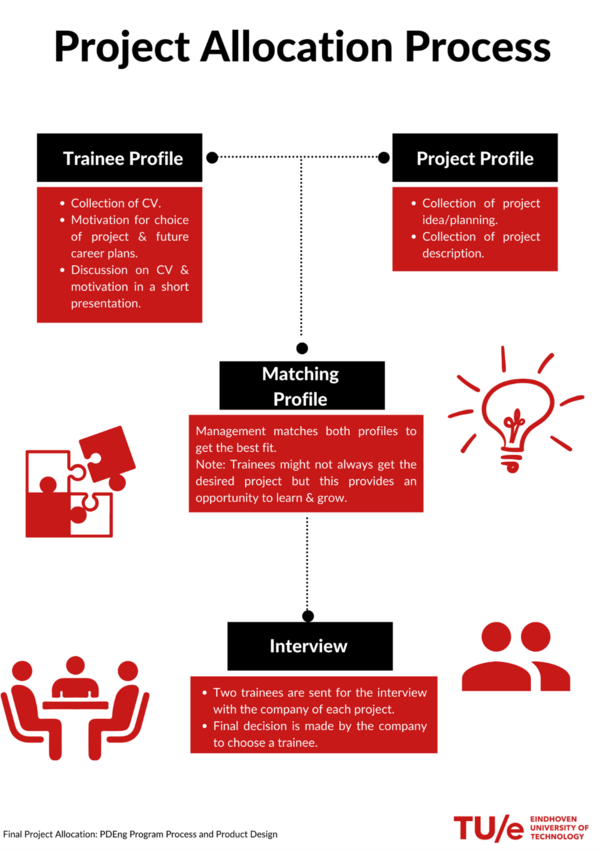After the curricular year, the technological design projects are carried out in the second year of the program. These are challenging projects with a high reality value that are aimed at the development of the trainee design engineers' abilities. In the project, a specific design objective must be reached within a restricted period of time and with limited means. Projects have an integrative character through the application of several (sub)disciplines.
A design assignment is distinct from a research assignment in that the emphasis lies on synthesis (rather than on analysis), and account is taken of the technical and economic preconditions.
A design assignment differs from a (fundamental) research assignment in a number of ways:
- a design assignment is characterized by analysis, followed by synthesis; a research assignment by analysis which raises new questions
- a design assignment is aimed at a specific objective (a plant, equipment, system) or product
- in this, the result of a design assignment is bound by practical limitations. It must suit the local context
- technical and economic preconditions must be taken into account.
Project allocation process
The PPD team acquires projects from industry each year. This means that we never have the same projects each year, and we do not know in advance what kind of projects we will have. We always aim to make the best match for a project and trainee. Below you will find a short explanation and infographic on the project allocation process.
Projects are assigned by the PPD supervisory staff, taking into account the requirements set by the industry partner as well as the trainee’s experience and fields of interest. In general, two trainees are sent to an interview hosted by the industry partner. These interviews take place during the last months of the first year.
In the end, the industry partner chooses a trainee.

Examples of PPD projects
PPD projects are quite diverse. Here are some examples:
- Cooling without Corrosion – Company: ASML:
Due to the complexity of photolithographic systems, cooling systems which keep the temperature stable are a key design concern. These systems require a high system availability to support production and therefore only ASML-approved coolants are recommended to ASML’s clients. The most common risk to reliable cooling is corrosion. This PPD trainee was tasked to identify a means to eliminate or reduce the incidence of corrosion in ASML’s cooling systems. Experimental investigation by the PPD trainee revealed a means to achieve this stated goal. A conceptual design was delivered to ASML for incorporation of the findings in the existing cooling system design.
- Thermal and spectral data analysis and image processing for Wire Arc Additive Manufacturing – Company: RAMLAB and M2i:
Wire Arc Additive Manufacturing or WAAM is a modern 3D metal printing technology which has the potential to print large components. Key system performance metrics are efficiency, stability and robustness. A PPD trainee was tasked to use physical data (such as acoustic and high frequency data, as well as optical emission spectroscopy) in order to find links between the welding parameters and the final quality. Resulting correlations enabled RAMLAB to improve the monitoring and control of the deposition process, as well as increasing the level of automation.
- Iron powder for a solar-powered plant – Company: Shell:
The oil and gas giant Shell is in many aspects the leading company in the energy transition. A major challenge intrinsic to renewable energy sources is intermittency since the power output from solar/wind is not continuous. Society and industry, specifically chemical operations, need uninterrupted power. To address this, energy must be stored in an energy carrier. Iron powder has the advantage of having higher energy density than batteries or hydrogen, and of being intrinsically safe. A PPD trainee performed a techno-economic evaluation of an Fe-cycle for energy storage in a methanol producing plant. During times of low energy supply the combustion of iron powder generates the energy needed to run the plant. During times of high energy availability iron oxide particles are reduced using renewable hydrogen, creating a CO2-free cycle.
- Future Energy Roadmap: Cargill Sas van Gent site – Company: Cargill:
Climate change calls for a change in emissions all around the world. Cargill has set an ambitious goal to reduce air?? emissions with 23% by 2025 using 2017 as a reference. This project takes place at the Cargill Sas van Gent site. Projects for energy optimisation, and associated emission reduction, were developed by a PPD trainee. Heat pump integration, electrification and utility optimization play a big role here. The trainee's role is to develop existing solutions and identify new optimization opportunities to create an energy roadmap that enables the 2025 emission goal.